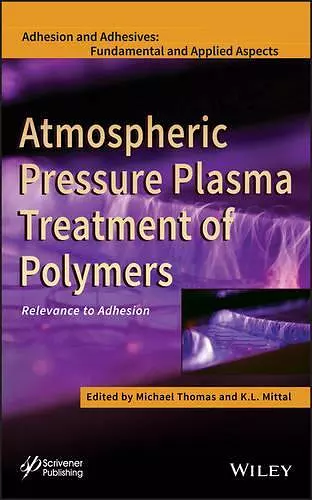Atmospheric Pressure Plasma Treatment of Polymers
Relevance to Adhesion
Michael Thomas editor K L Mittal editor
Format:Hardback
Publisher:John Wiley & Sons Inc
Published:28th Jun '13
Currently unavailable, and unfortunately no date known when it will be back

An indispensable volume detailing the current and potential applications of atmospheric pressure plasma treatment by experts practicing in fields around the world
Polymers are used in a wide variety of industries to fabricate legions of products because of their many desirable traits. However, polymers in general (and polyolefins, in particular) are innately not very adhesionable because of the absence of polar or reactive groups on their surfaces and concomitant low surface energy. Surface treatment of polymers, however, is essential to impart reactive chemical groups on their surfaces to enhance their adhesion characteristic. Proper surface treatment can endow polymers with improved adhesion without affecting the bulk properties.
A plethora of techniques (ranging from wet to dry, simple to sophisticated, vacuum to non-vacuum) for polymer surface modification have been documented in the literature but the Atmospheric Pressure Plasma (APP) treatment has attracted much attention because it offers many advantages vis-a-vis other techniques, namely uniform treatment, continuous operation, no need for vacuum, simplicity, low cost, no environmental or disposal concern, and applicability to large area samples.
Although the emphasis in this book is on the utility of APP treatment for enhancement of polymer adhesion, APP is also applicable and effective to modulate many other surface properties of polymers: superhydrophilicity, superhydrophobicity, anti-fouling, anti-fogging, anti-icing, cell adhesion, biocompatibility, tribological behavior, etc.
The key features of Atmospheric Pressure Plasma Treatment of Polymers:
- Address design and functions of various types of reactors
- Bring out current and potential applications of APP treatment
- Represent the cumulative wisdom of many key academic and industry researchers actively engaged in this key and enabling technology <
“The information provided in this book should be of great interest and value to surface and chemical engineers as well as R&D, manufacturing, and quality control personnel in a host of industries and technological areas such as printing, textile, adhesive bonding, packaging, automotive, aerospace, composites, microfluidics, biomedical, paint, microelectronics, and nanotechnology.” (Materials and Corrosion, 1 August 2013)
ISBN: 9781118596210
Dimensions: 241mm x 163mm x 25mm
Weight: 721g
416 pages